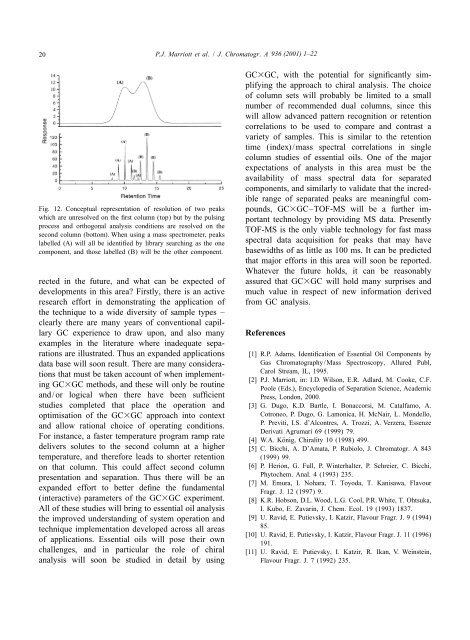Gas chromatographic technologies for the analysis of essential oils
Gas chromatographic technologies for the analysis of essential oils
Gas chromatographic technologies for the analysis of essential oils
Create successful ePaper yourself
Turn your PDF publications into a flip-book with our unique Google optimized e-Paper software.
20 P.J. Marriott et al. / J. Chromatogr. A 936 (2001) 1–22<br />
Fig. 12. Conceptual representation <strong>of</strong> resolution <strong>of</strong> two peaks<br />
which are unresolved on <strong>the</strong> first column (top) but by <strong>the</strong> pulsing<br />
process and orthogonal <strong>analysis</strong> conditions are resolved on <strong>the</strong><br />
second column (bottom). When using a mass spectrometer, peaks<br />
labelled (A) will all be identified by library searching as <strong>the</strong> one<br />
component, and those labelled (B) will be <strong>the</strong> o<strong>the</strong>r component.<br />
GC3GC, with <strong>the</strong> potential <strong>for</strong> significantly simplifying<br />
<strong>the</strong> approach to chiral <strong>analysis</strong>. The choice<br />
<strong>of</strong> column sets will probably be limited to a small<br />
number <strong>of</strong> recommended dual columns, since this<br />
will allow advanced pattern recognition or retention<br />
correlations to be used to compare and contrast a<br />
variety <strong>of</strong> samples. This is similar to <strong>the</strong> retention<br />
time (index)/mass spectral correlations in single<br />
column studies <strong>of</strong> <strong>essential</strong> <strong>oils</strong>. One <strong>of</strong> <strong>the</strong> major<br />
expectations <strong>of</strong> analysts in this area must be <strong>the</strong><br />
availability <strong>of</strong> mass spectral data <strong>for</strong> separated<br />
components, and similarly to validate that <strong>the</strong> incredible<br />
range <strong>of</strong> separated peaks are meaningful compounds,<br />
GC3GC–TOF-MS will be a fur<strong>the</strong>r im-<br />
portant technology by providing MS data. Presently<br />
TOF-MS is <strong>the</strong> only viable technology <strong>for</strong> fast mass<br />
spectral data acquisition <strong>for</strong> peaks that may have<br />
basewidths <strong>of</strong> as little as 100 ms. It can be predicted<br />
that major ef<strong>for</strong>ts in this area will soon be reported.<br />
Whatever <strong>the</strong> future holds, it can be reasonably<br />
assured that GC3GC will hold many surprises and<br />
much value in respect <strong>of</strong> new in<strong>for</strong>mation derived<br />
from GC <strong>analysis</strong>.<br />
rected in <strong>the</strong> future, and what can be expected <strong>of</strong><br />
developments in this area Firstly, <strong>the</strong>re is an active<br />
research ef<strong>for</strong>t in demonstrating <strong>the</strong> application <strong>of</strong><br />
<strong>the</strong> technique to a wide diversity <strong>of</strong> sample types –<br />
clearly <strong>the</strong>re are many years <strong>of</strong> conventional capillary<br />
GC experience to draw upon, and also many References<br />
examples in <strong>the</strong> literature where inadequate separations<br />
are illustrated. Thus an expanded applications [1] R.P. Adams, Identification <strong>of</strong> Essential Oil Components by<br />
data base will soon result. There are many considera-<br />
<strong>Gas</strong> Chromatography/Mass Spectroscopy, Allured Publ,<br />
tions that must be taken account <strong>of</strong> when implement-<br />
Carol Stream, IL, 1995.<br />
[2] P.J. Marriott, in: I.D. Wilson, E.R. Adlard, M. Cooke, C.F.<br />
ing GC3GC methods, and <strong>the</strong>se will only be routine<br />
Poole (Eds.), Encyclopedia <strong>of</strong> Separation Science, Academic<br />
and/or logical when <strong>the</strong>re have been sufficient Press, London, 2000.<br />
studies completed that place <strong>the</strong> operation and [3] G. Dugo, K.D. Bartle, I. Bonaccorsi, M. Catalfamo, A.<br />
optimisation <strong>of</strong> <strong>the</strong> GC3GC approach into context<br />
Cotroneo, P. Dugo, G. Lamonica, H. McNair, L. Mondello,<br />
and allow rational choice <strong>of</strong> operating conditions.<br />
P. Previti, I.S. d’Alcontres, A. Trozzi, A. Verzera, Essenze<br />
Derivati Agrumari 69 (1999) 79.<br />
For instance, a faster temperature program ramp rate<br />
[4] W.A. Konig, ¨ Chirality 10 (1998) 499.<br />
delivers solutes to <strong>the</strong> second column at a higher [5] C. Bicchi, A. D’Amata, P. Rubiolo, J. Chromatogr. A 843<br />
temperature, and <strong>the</strong>re<strong>for</strong>e leads to shorter retention (1999) 99.<br />
on that column. This could affect second column [6] P. Herion, G. Full, P. Winterhalter, P. Schreier, C. Bicchi,<br />
presentation and separation. Thus <strong>the</strong>re will be an<br />
Phytochem. Anal. 4 (1993) 235.<br />
[7] M. Emura, I. Nohara, T. Toyoda, T. Kanisawa, Flavour<br />
expanded ef<strong>for</strong>t to better define <strong>the</strong> fundamental Fragr. J. 12 (1997) 9.<br />
(interactive) parameters <strong>of</strong> <strong>the</strong> GC3GC experiment. [8] K.R. Hobson, D.L. Wood, L.G. Cool, P.R. White, T. Ohtsuka,<br />
All <strong>of</strong> <strong>the</strong>se studies will bring to <strong>essential</strong> oil <strong>analysis</strong> I. Kubo, E. Zavarin, J. Chem. Ecol. 19 (1993) 1837.<br />
<strong>the</strong> improved understanding <strong>of</strong> system operation and [9] U. Ravid, E. Putievsky, I. Katzir, Flavour Fragr. J. 9 (1994)<br />
technique implementation developed across all areas<br />
85.<br />
[10] U. Ravid, E. Putievsky, I. Katzir, Flavour Fragr. J. 11 (1996)<br />
<strong>of</strong> applications. Essential <strong>oils</strong> will pose <strong>the</strong>ir own 191.<br />
challenges, and in particular <strong>the</strong> role <strong>of</strong> chiral [11] U. Ravid, E. Putievsky, I. Katzir, R. Ikan, V. Weinstein,<br />
<strong>analysis</strong> will soon be studied in detail by using Flavour Fragr. J. 7 (1992) 235.











![Bericht von Schimmel & Co. [Inhaber Gebr. Fritzsche] in Leipzig](https://img.yumpu.com/24438150/1/171x260/bericht-von-schimmel-co-inhaber-gebr-fritzsche-in-leipzig.jpg?quality=85)




